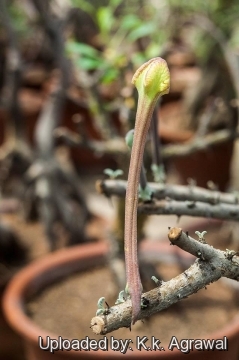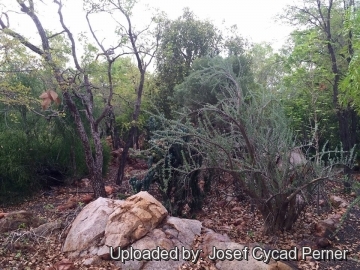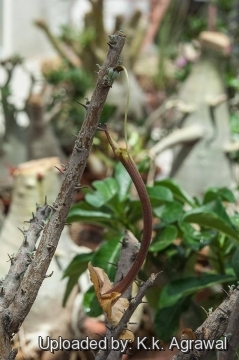




Your support is critical to our success.
- Encyclopedia of SUCCULENTS
- Encyclopedia Index
- Families
- Genera
- Species
- Pedaliaceae
- Sesamothamnus
- Caudiciforms
Since 4 Aug 2013
Fl. Trop. Afr. [Oliver et al.] 4: II. 568 (1906
Family: PEDALIACEAE

Origin and Habitat: Sesamothamnus lugardiiSN|28091]]SN|28091]] is found in several separated populations from the Transvaal Lowveld (Kruger National Park) through the northern Transvaal in Southern Africa to the south of Zimbabwe and the east of Botswana and southern Namibia.
Altitude range: 180 - 1500 metres above sea level.
Habitat: It grows singly or in scattered, small groups in hot dry areas on calcareous soil in open, sandy Acacia Bushveld or between rocks, in scrub communities, sometimes being the dominant woody plant. The elephants have been known to eat parts of the tree, and sometimes to uproot it.
Synonyms:
- Sesamothamnus lugardii N.E.Br. ex Stapf
Sesamothamnus lugardii N.E.Br. ex Stapf
Fl. Trop. Afr. [Oliver et al.] 4: II. 568 (1906
Synonymy: 2
- Sesamothamnus lugardii N.E.Br. ex Stapf
- Sesamothamnus seineri Engl.
ENGLISH: Transvaal sesame-bush, Eastern sesame-bush
AFRIKAANS (Afrikaans): Transvaalse sesambos, Sesambos, Baster-spekboom, Kanniedood, Koedoebos
TSWANA (Setswana): Moboana, Siboana
VENDA (Tshivenḓa / Luvenḓa): Tshinonzhe
Description: Sesamothamnus lugardiiSN|28091]]SN|28091]] is a grotesque spiny shrub or small caudiciform tree which looks like a 2-3(-5) m high baobab. It has an exceptionally thick, swollen trunk which always subdivides near the ground in few main branches tapering rapidly towards their tips to form a sparse canopy. The flowers of this species are unique, beautiful trumpet-shaped, but unfortunately very few are produced. Each consists of a particularly long, thin, red-brown corolla tube which is elongated at the base into what is known as a 'spur', which extends beyond the flower's junction with the twig.
Stem (Caudex): Succulent-like, very swollen at the base, up to 1 m. in diameter. It branches very low down into a few thick, semi-erect branches that divide into thick branchlets that taper rapidly towards their tips. Bark golden-yellow fairly glossy, marked with black, peeling off in small flakes, to show shiny green under-bark. The bark becomes darker towards the ends of the branches. The branches have dark knobs and stiff thorns. The timber is soft, fibrous and worthless.
Thorns: Single, short, set spirally on the twigs 5-10(-15) mm long, straight or slightly curved growing on twigs and branches. Initially they are soft with leaf-like appendages, but later become hard and sharp.
Leaves: Deciduous, simple in tufts on knobs, in the angles made by the spines, or forming tight, sparse sleeves around short branchlets and twigs, oblong to obovate, 1–2.5 cm long, 4–6 mm broad, blue-grey-green, semi-coriaceous, with under-surfaces covered by many, tiny, star-shaped hairs that give a powdery appearance when young. Petiole very short . Margin smooth. Tip rounded-to-notched. Base tapering. Midrib and veins, distinct below, impressed above without hairs.
Flower: Striking, sweet-scented, single or up to 3 in short raceme-like inflorescences on short shoots which are sometimes elongated. Pedicels 4 mm long. Calyx 5-partite, 4 mm. Long. Flower-tube long, cylindrical, only slightly curved, thin, red-brown 8-10(-15) cm long, 4–6 mm in diameter, with a short spur at base of tube, 1–1.5 cm long, cream-coloured, sometimes suffused with purple. Corolla star-like, 50 - 60 mm in diameter, sparingly tomentose, opening into five, broad, petals which are subcircular, 1.6–2 cm. broad crinkled, white to pale cream-coloured. Stamens 4, subequal, inserted near the throat of the corolla tube; filaments 4–5 mm long. Style slender, equaling the corolla tube. Stigma reaching the corolla mouth or exerted by up to 10 mm., broadly bilobed.
Blooming season: Summer.
Fruits (capsules): Flat, pale greyish brown, woody approx 40-60mm long, 38-50 mm broad, heart-shaped, rectangular or egg-shaped in outline, laterally compressed, often with a blunt, notched tip sometimes with a long, rigid, hair-like strand resembling that of the jacaranda. It is thickened in the middle and stands upright. It splits open widely, to release the seeds.
Seeds Brown, flat, transversely oblong, with round, papery wings, about 1.5 cm long and 2.5 cm broad (including the wings).
Notes: The name lugardii honours Major EJ Lugard, a naturalist who collected plants in Namaqualand during the late 1800s.
Bibliography: Major references and further lectures
1) Ernst Schmidt, Mervyn Lotter, Warren McCleland “Trees and Shrubs of Mpumalanga and Kruger National Park” Jacana Media, 01/Jan/2002
2) Vincent Carruthers “The Wildlife of Southern Africa: A Field Guide to the Animals and Plants of the Region” Struik, 01/Mar/2005
3) Rina Grant, Val Thomas “Sappi Tree Spotting: Bushveld, Including Pilanesberg and Magaliesberg” Jacana Media, 01/Jan/2005
4) Piet Van Wyk “Southern African Trees: A Photographic Guide” Struik, 2001
5) Werner Rauh “The Wonderful World of Succulents: Cultivation and Description of Selected Succulent Plants Other Than Cacti” Smithsonian Institution Press, 1984
6) Jutta Von Breitenbach “Pocket List of Southern African Indigenous Trees: Including Selected Shrubs and Woody Climbers” Briza Publications, 01/Jan/2001
7) Clive Innes “Complete Handbook of Cacti and Succulents” Van Nostrand Reinhold Company, 01/Dec/1981
8) Inez C. Verdoorn, L. E. W. Codd “Wild Flowers of the Transvaal” Trustees, Wild Flowers of The Transvaal Book Fund, 1962
9) Sesamothamnus lugardii in: Bothalia 3: 254 1937
10) Sesamothamnus lugardii in: Fl. Pl. Africa 41: t.1640 1971
11) Sesamothamnus lugardii in: List South. African Succ. Pl. : 135 1997
12) H. D. Ihlenfeldt “Flora Zambesica” Vol 8 Part 3, page 86 1988
13) Bruce in Kew Bull. 8: 417 1953
14) Codd, Trees & Shrubs Kruger Nat. Park: 168 1951
15) Pardy in Rhod. Agric. Journ. 53: 63 (1956
16) Codd in Fl. Pl. Afr. pl. 1640 1972
17) Palmer & Pitman, Trees of S. Afr.: 2015 1972
18) Coates & Palgrave, Trees of S. Afr.: 835 1977

Sesamothamnus lugardii Photo by: K.k. Agrawal

Sesamothamnus lugardii Photo by: Josef Cycad Perner

Sesamothamnus lugardii Photo by: K.k. Agrawal
The gallery now contains thousands of pictures, however it is possible to do even more. We are, of course, seeking photos of species not yet shown in the gallery but not only that, we are also looking for better pictures than those already present. Read More...
Cultivation and Propagation: Sesamothamnus lugardiiSN|28091]]SN|28091]] is fairly easy to grow both indoors, as well as outdoors in warm climates in a garden with well-drained soil, especially a rock garden and can grow at about 10cm a year. In the winters it is deciduous, except in very tropical areas. It is drought but not frost-resistant.
Growth rate: It is a fairly slow growing plant, but in 10 years it can easily outgrow its indoor location, requiring a 'pruning'. Though branching is usually a response to naturally process one can stimulate branching by cutting off its top. It has amazing regenerative properties and is suited for bonsai culture.
Soil: It needs a draining cactus potting mix.
Repoting: Repot the plant every 3 years; this is quite tricky given all the spines. The best way is to wrap several layers of newspaper around the trunk where it is to be handled.
Waterings: It needs regular water when the plant has leaves, contrary to popular belief, it likes a lot of water in the warm summers, as long as it's planted in a very well draining soil. Indoors it is best to err on the dry side, or it is prone to rot.
Exposures: It like full sun to light shade with warm temperatures.
Propagation: Seeds or cuttings. These trees are difficult to grow from seed, as planted seeds germinate poorly. Seed start sprouting in just 3-4 days ( but continue to germinate erratically for about 6 month). They are also propagated by removal of small offshoots that grow at the base of the old plant. Carefully break off the offshoots, they should be allowed to dry for 5 to 8 days before potting up.
| Your Actions | |
|---|---|
| Back to Sesamothamnus index | |
| Back to Pedaliaceae index | |
 |
Back to Succulents Encyclopedia index |
Privacy stantement - Terms and conditions - How to cite - About us - Feedback - Donate




